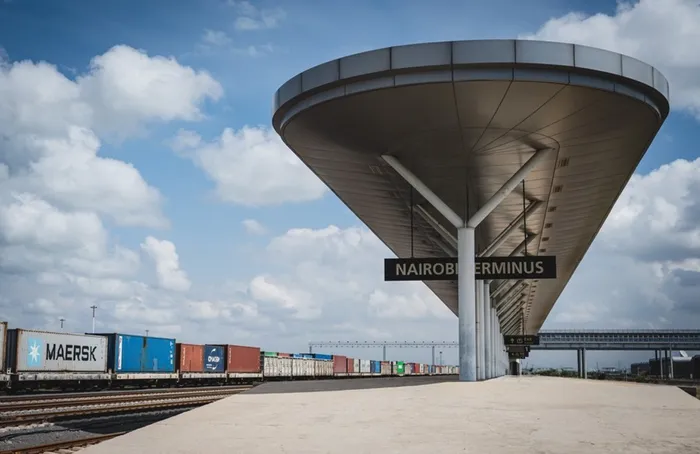China presses on, repositioning its Belt and Road Initiative

Picture: Wang Guansen / Xinhua / Taken on May 23, 2023 – A platform of the Mombasa-Nairobi Railway in Nairobi, Kenya. The Mombasa-Nairobi Standard Gauge Railway in Kenya has become a flagship project of China-Africa co-operation, a show of Chinese enterprises and a demonstration project of the Belt and Road Initiative.
By David Monyae
The world should expect a major qualitative shift in Chinese President Xi Jinping’s flagship Belt and Road Initiative (BRI) – a Chinese-backed global infrastructure programme announced by the Chinese leader upon assuming power in 2013. This was the key message conveyed by Xi’s keynote address at the third Belt and Road Forum for International Co-operation.
Over the past 10 years, China has entered into 200 BRI co-operation agreements with 152 countries and more than 30 international organisations, according to a White Paper published by the Chinese government just before the forum. In Africa, a Continent which faces a huge infrastructure funding deficit, 49 countries and the African Union Commission (AUC) are signatories to the initiative.
Underpinned by the goals of policy co-ordination, connectivity, unimpeded trade, financial integration and people-to-people relations, the BRI has seen more than 3,000 development projects – including ports, highways, railways, power plants, 4G and 5G wireless networks, bridges and airports among others – completed in various countries funded by the Chinese policy banks namely, the China Development Bank (CDB) and the Export-Import Bank of China.
Other contributors include the Silk Road Fund and the multilateral Asia Infrastructure Investment Bank (AIIB) with some commercial Chinese lenders also chipping in with additional funding. Since 2013 when the BRI was announced, these entities have collectively availed more than $330bn in funding for infrastructure projects.
Some of the biggest projects in the BRI fold include the $62bn China-Pakistan Economic Corridor (CPEC), the $4.5bn Jakarta-Bandung highspeed rail, the Forest City in Malaysia and the $1.5bn Hambantota port in Sri Lanka, to mention a few. Africa has also benefited from the BRI significantly having received $91bn between 2013 and 2021 which went to numerous infrastructure projects. These include the $3,2bn Mombasa-Nairobi railway in Kenya, $1,5bn Lagos-Ibadan railway in Nigeria, the $4.2 billion Addis Ababa-Djibouti railway, the $1.4bn Karuma hydropower station in Uganda and the $500 million Memvele hydropower plant in Cameroon.
A White Paper published by China’s State Council in 2021 claimed that between 2000-2020 China constructed and funded more than 13,000km of roads and railways, over 80 largescale power plants and 130 medical facilities. Most of these projects were implemented after the promulgation of the BRI. However, the BRI came under heavy criticism for flouting environmental regulations, ignoring human rights, corrupt awarding of tenders, contributing to climate change through greenhouse gas emissions, and saddling poor countries with unsustainable debt.
In countries such as Zambia and Kenya, the lax environmental and human rights standards in Chinese projects have resulted in clashes with civil society groups and in some cases the abandonment of projects.
Moreover, others have argued that BRI infrastructure facilitates China’s extraction of primary commodities from Africa while also deepening the continent’s dependence on Chinese technology and standards, especially in the rail, energy, and digital sectors.
However, it’s not all doom and gloom as some BRI projects have had a positive impact through improving welfare, opening trade channels, economic growth and transferring technology. For example, the Chinese-funded Mombasa-Nairobi railway in Kenya is reported to have increased passenger numbers by over 150% and annual cargo capacity by over 400%. The travel time for passengers has been reduced from 10 hours to four hours while that for cargo has been reduced to eight hours, meaning that more people and more goods can be moved faster and cheaper.
The next phase of the BRI as outlined by Xi at the forum, which he called “high-quality Belt and Road co-operation” seems to be a response to the criticism in a bid to improve the initiative. Contrary to the predictions of some that China was going to abandon the BRI, the Chinese leader announced that the policy banks namely the CDB and the Exim Bank will arrange a $48.75bn financing window each for infrastructure projects under the BRI.
The Silk Road Fund will receive an injection of $11bn. Although this is a downsize from the previous financial commitments towards BRI, it is nonetheless a demonstration of China’s resolve to press on with the initiative. In his speech, Xi announced that China would embark on eight major steps in the BRI which include promoting infrastructural connectivity, promoting trade, focusing on both big and small projects, promoting green development, advancing science, technology and innovation, people-to-people exchanges, promoting the integrity of BRI projects and strengthening institutional co-operation between BRI countries.
Interestingly, a secretariat will be established for the BRI forum which will help to better co-ordinate BRI projects. The establishment of such a secretariat gives the BRI a sense of permanence. As many have pointed out, China is aware of the geopolitical value it gets from the BRI, especially in the Global South, hence its determination to press on with the initiative. The infrastructure projects rolled out in the first 10 years of the programme have cemented China’s place as the leader of the developing world and strengthened its case for global leadership.
Meanwhile, the US-led Partnership for Global Infrastructure Investment (PGII) announced last year is promising to mobilise hundreds of billions of dollars to fund infrastructure projects in the Global South in what many see as competition with the BRI. However, the PGII has thus far not yielded anything tangible, and it remains to be seen how it will unfold in the coming years.
David Monyae is Associate Professor of International Relations and Political Science, and Director of the Africa-China Studies Centre at the University of Johannesburg